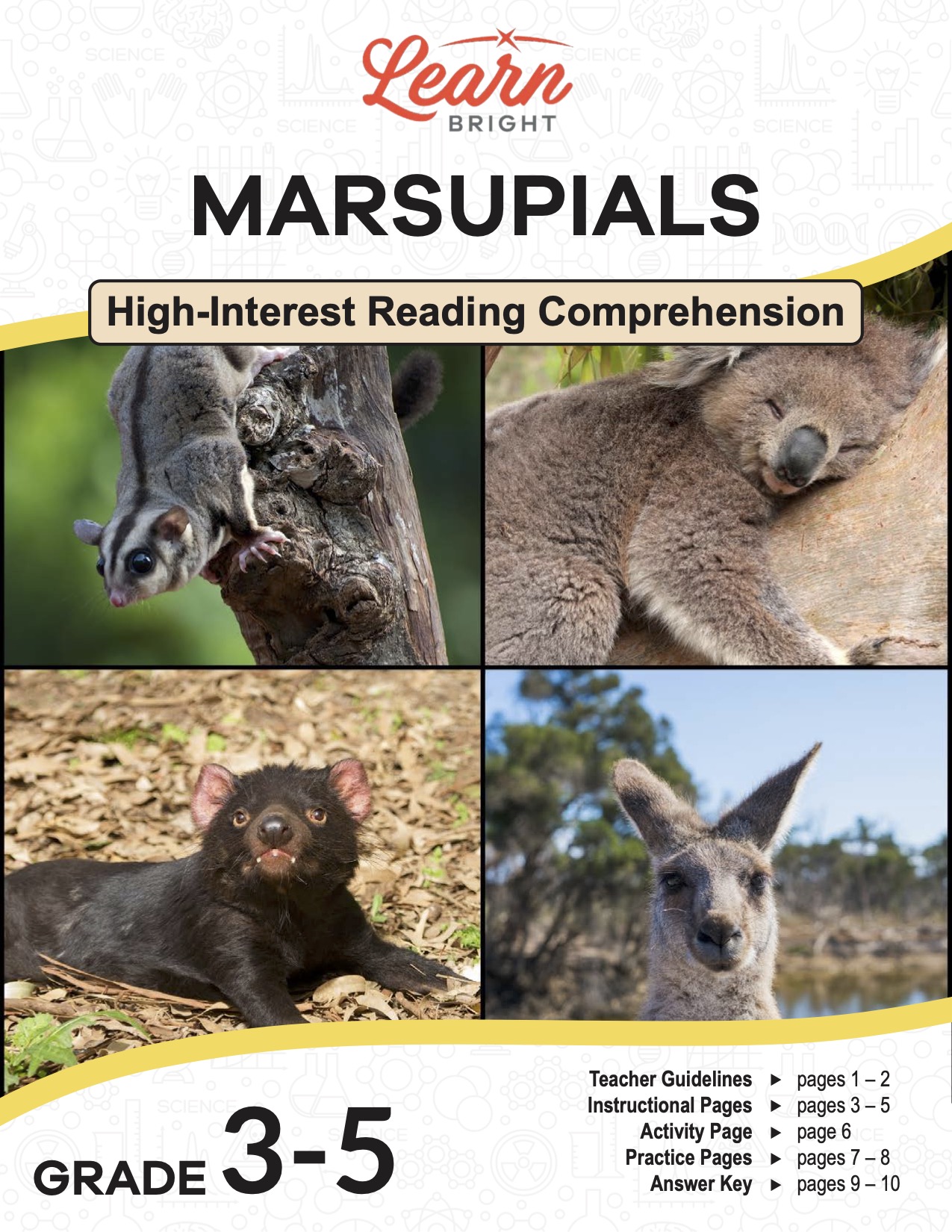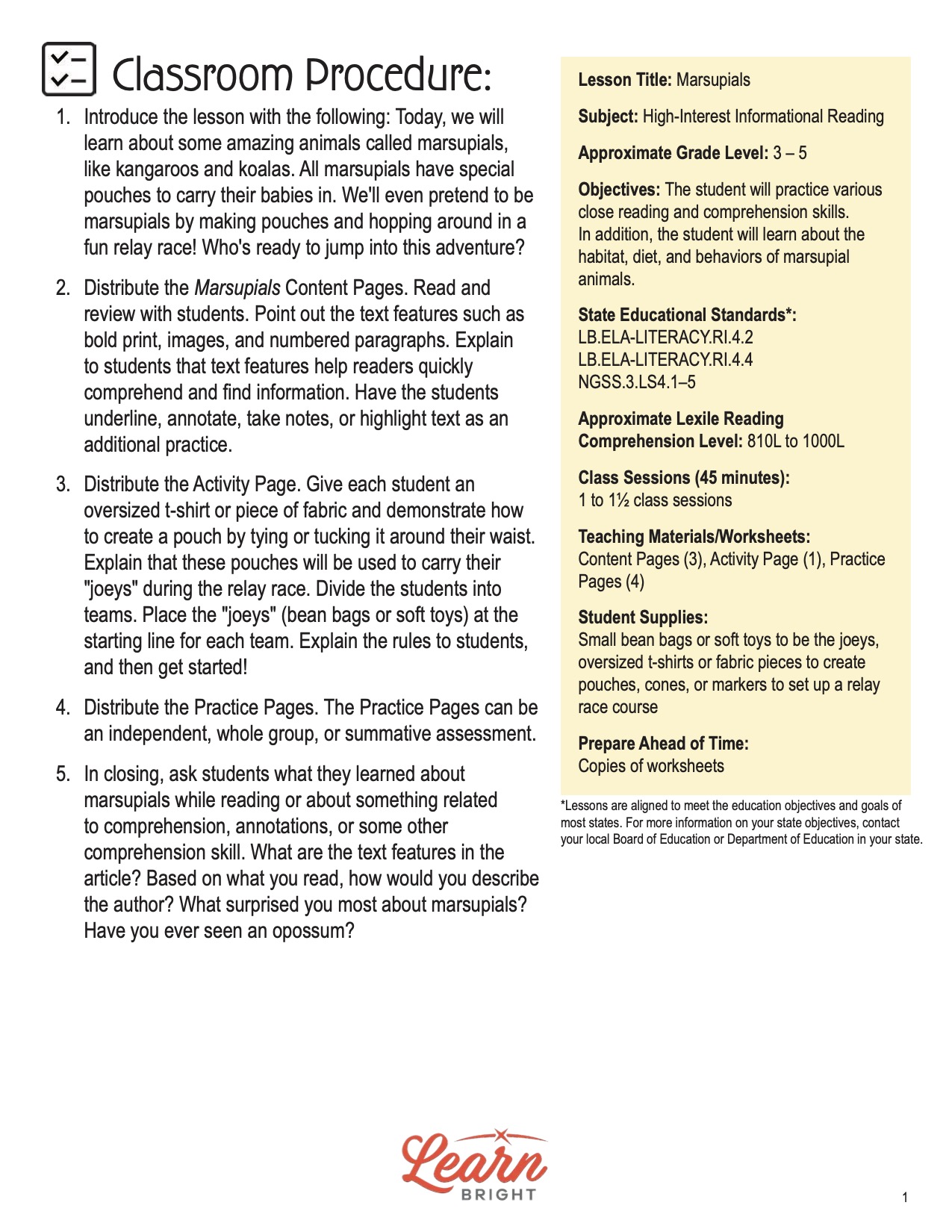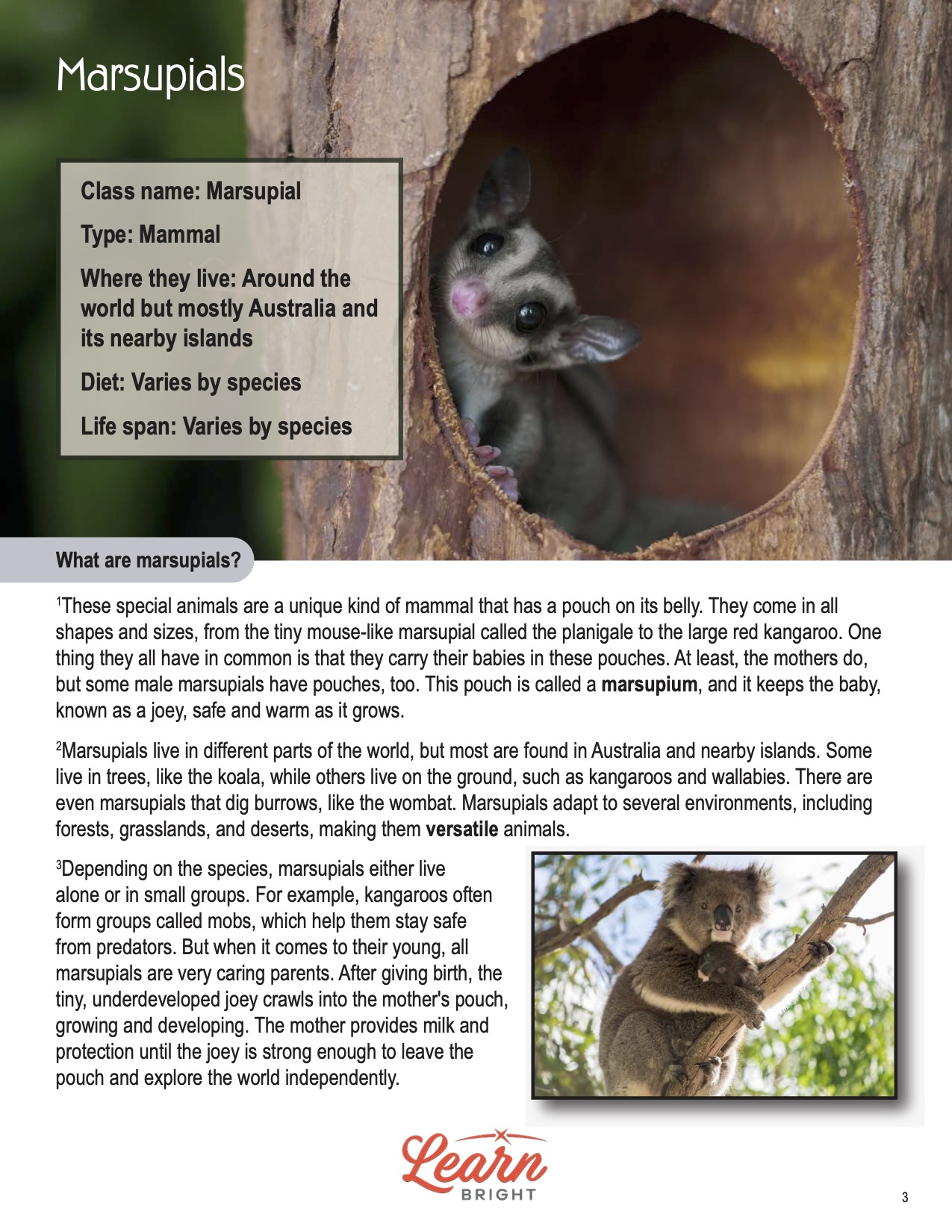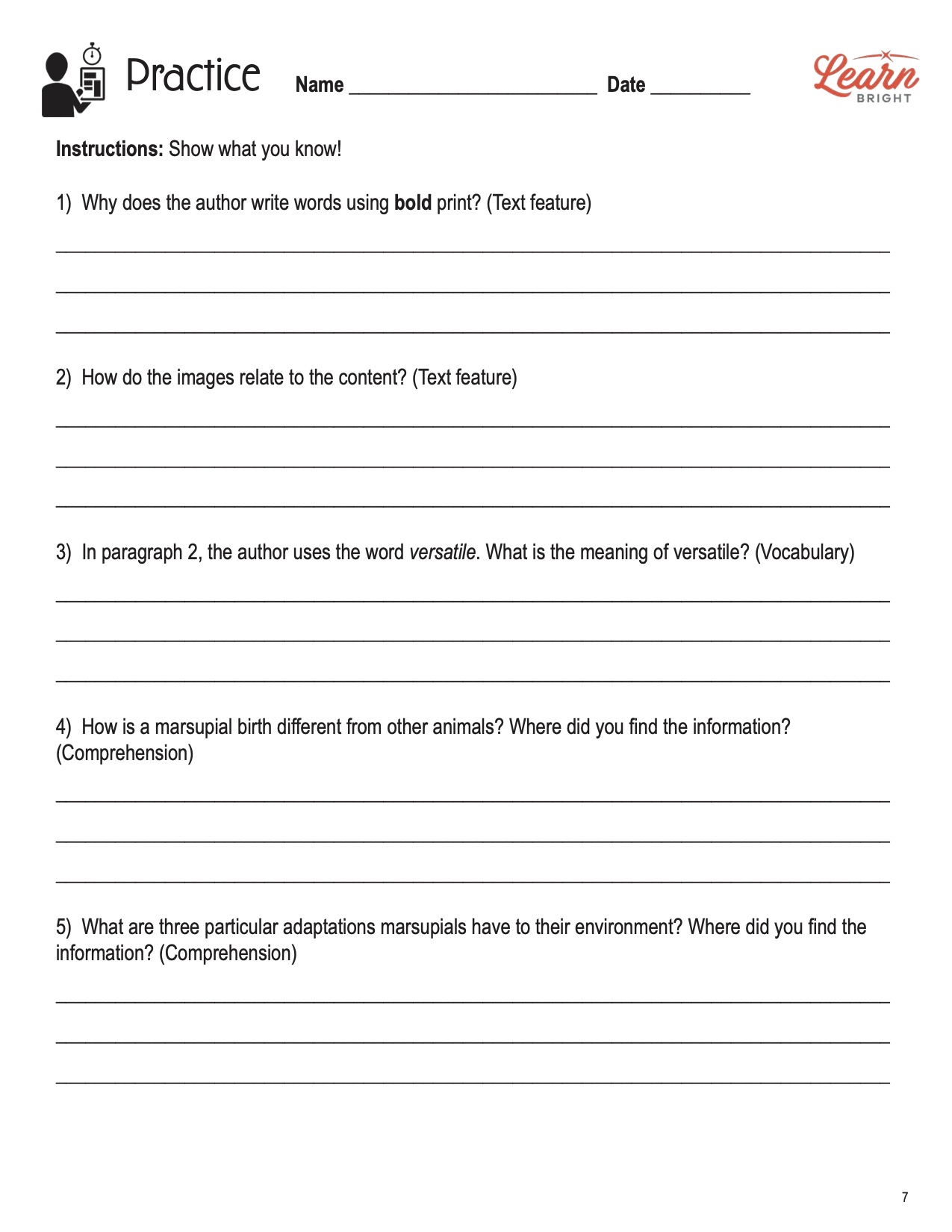Description
What our Marsupials lesson plan includes
Lesson Objectives and Overview: Marsupials is a high-interest reading comprehension lesson plan. As such, students will practice various close reading and comprehension skills. In addition, they will learn about the habitat, diet, and behaviors of various animals in the marsupial class. This lesson is for students in 3rd grade, 4th grade, and 5th grade.
Classroom Procedure
Every lesson plan provides you with a classroom procedure page that outlines a step-by-step guide to follow. You do not have to follow the guide exactly. The guide helps you organize the lesson and details when to hand out worksheets. It also lists information in the yellow box that you might find useful. You will find the lesson objectives, state standards, and number of class sessions the lesson should take to complete in this area. In addition, it describes the supplies you will need as well as what and how you need to prepare beforehand.
Teacher Notes
The teacher notes page provides an extra paragraph of information to help guide the lesson. It explains that you can teach this lesson in a whole-class setting or as an independent, small-group activity. You can use the blank lines to write down any other ideas or thoughts you have about the topic as you prepare. The activity for this lesson requires small bean bags or soft toys to be the joeys, oversized t-shirts or fabric pieces to create pouches, and cones or markers to set up a relay race course.
MARSUPIALS LESSON PLAN CONTENT PAGES
What Is a Marsupial?
The Marsupials lesson plan contains three content pages. It begins by providing a box of background information about this animal. Marsupials are mammals that live all around the world, but mostly in Australia and its surrounding islands. Their diets vary by species, as do their life spans.
These special animals are a unique kind of mammal that has a pouch on its belly. They come in all shapes and sizes, from the tiny mouse-like marsupial called the planigale to the large red kangaroo. One thing they all have in common is that they carry their babies in these pouches. At least, the mothers do, but some male marsupials have pouches, too. This pouch is called a marsupium, and it keeps the baby, known as a joey, safe and warm as it grows.
Marsupials live in different parts of the world, but most are found in Australia and nearby islands. Some live in trees, like the koala, while others live on the ground, such as kangaroos and wallabies. There are even marsupials that dig burrows, like the wombat. Marsupials adapt to several environments, including forests, grasslands, and deserts, making them versatile animals.
Depending on the species, marsupials either live alone or in small groups. For example, kangaroos often form groups called mobs, which help them stay safe from predators. But when it comes to their young, all marsupials are very caring parents. After giving birth, the tiny, underdeveloped joey crawls into the mother’s pouch, growing and developing. The mother provides milk and protection until the joey is strong enough to leave the pouch and explore the world independently.
Marsupial Diets
Marsupials have different diets depending on the species. Kangaroos, for instance, are herbivores because they eat only plants. They graze on grasses and leaves, using their strong front teeth to cut the vegetation. Koalas are also herbivores, and they eat mainly eucalyptus leaves. Other marsupials, like the Tasmanian devil, are carnivores, so they only eat meat. They hunt small animals or scavenge for dead animals using their sharp teeth and strong jaws.
To catch their prey, carnivorous marsupials like the Tasmanian devil rely on their keen senses and agility. They have sharp claws to grab their prey and powerful teeth to bite and tear meat. Some marsupials are insectivores, which means they eat insects. Numbats are a great example. They use long, sticky tongues to catch termites inside logs and underground tunnels. Each marsupial species has adapted its hunting and feeding techniques to match its diet and environment.
Interesting Facts
One interesting fact is that marsupials experience a special kind of birth. Unlike most mammals, marsupials give birth to very tiny, underdeveloped babies. These babies are sometimes as small as a jellybean! After they are born, the babies crawl into their mother’s pouch, where they continue to grow and develop. The pouch provides a safe and warm environment with plenty of milk.
Some marsupials can jump incredibly high and far. Kangaroos can jump over six feet high and cover up to 25 feet in a single leap! They use their strong hind legs and oversized feet to make these impressive jumps. This ability helps them travel quickly across the grasslands and escape from predators. Their long, muscular tails also help them balance as they hop around.
Each species of marsupial has particular adaptations for their environment. Koalas have a highly specialized diet of eucalyptus leaves, which are tough and not very nutritious. They have a long digestive tract that helps them break down these leaves and extract the necessary nutrients. The sugar glider has a membrane called a patagium that stretches from its wrists to its ankles, allowing it to glide between trees. This gliding ability helps it escape predators and find food more efficiently.
Why They’re Important
Marsupials are essential for the environment because they contribute to the balance of their ecosystems. Kangaroos help keep grasslands healthy by grazing on plants, which prevents overgrowth and promotes new plant growth. Wombats dig burrows that can become homes for other animals. Plus, their digging helps aerate the soil to make it more suitable for plants. By eating insects, numbat marsupials help control insect populations, which can benefit the plants and animals in their habitat.
Unfortunately, some marsupials are endangered, which means they are at risk of disappearing forever. Many of these animals face threats like habitat loss due to human activities, such as deforestation and land development. Predators introduced by humans, like cats and foxes, also threaten marsupial populations. Conservation efforts, such as creating protected areas and breeding programs, can help save these unique animals. By protecting marsupials, we also help preserve the balance and health of their ecosystems.
MARSUPIALS LESSON PLAN WORKSHEETS
The Marsupials lesson plan includes two worksheets: an activity worksheet and a practice worksheet. Each one will help students solidify their grasp of the material they learned throughout the lesson. You can refer to the classroom procedure guidelines to know when to hand out each worksheet.
MARSUPIAL RELAY RACE ACTIVITY WORKSHEET
For this activity, students will participate in a relay race that involves hopping and crawling. They must tie a piece of fabric around their wastes to create a pocket that holds a “joey” (stuffed animal or similar item). You can divide the kids into teams beforehand and set up the course. After the activity, students will answer the three questions at the bottom of the page.
MARSUPIALS REVIEW PRACTICE WORKSHEET
The practice worksheet requires students to answer a series of 11 questions. These questions all relate to the content pages, so students will need to refer to them often for the answers. In addition, each question provides which reading tool the question corresponds to, such as text feature, vocabulary, or comprehension.
Worksheet Answer Keys
At the end of the lesson plan document is an answer key for the practice worksheet. The correct answers are all in red to make it easier for you to compare them with students’ responses. If you choose to administer the lesson pages to your students via PDF, you will need to save a new file that omits these pages. Otherwise, you can simply print out the applicable pages and keep these as reference for yourself when grading assignments.









